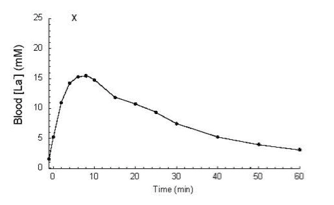Distance Running and Pitching?
-Rob Rabena by way of Eric Cressey-
Thank you for the wealth of information you continue to post.
For a guy just finishing his PT school career, I know that experience and wisdom often go hand-in-hand.
LACTATE IS NOT THE CAUSE OF MUSCULAR SORENESS IN PITCHERS.
So let’s talk blood lactate levels.
 In this study, “high levels” of blood lactate were considered as being between 10-15mM (Goodwin et al, 2007), which is double that of the average pitcher.
In this study, “high levels” of blood lactate were considered as being between 10-15mM (Goodwin et al, 2007), which is double that of the average pitcher.
Upper level athletes may approach max blood lactate levels of 15-25mM for all out exercise (30-120 seconds of duration). The peak values in the blood are typically around 3-8 minutes post-exercise, and they can remain elevated up to 60 minutes (Goodwin et al, 2007). Since they typically return to resting levels within one hour, there is no way this could be the cause of next day soreness.
Pitchers increased lactate production from 1.0mM (resting) to 5.3mM-5.8mM during a 7-inning simulated game contest (Potteiger et al, 1992). This is way less than the 8-10mM/L produced when squatting multiple repetitions at 70% of your 1 RM (Reynolds et al, 1997). However, I don’t see many people immediately going to run three miles post squat session because it will eliminate their soreness (because it won’t). 5mM is certainly not as much as the 15-25mM listed in the all-out exercise test; instead, it’s barely a 1/3 of what was found for max effort exercise. So, while it is technically above OBLA (onset of blood lactate accumulation at 4mM), this small increase should decrease to close to resting rate during each rest period between innings.
What about VO2?
The VO2 of endurance athletes can surpass 60 ml.kg.min (elite), but pitchers rarely ever push theirs over 20 (Potteiger et al, 1992).
Most college and professional pitchers are between the ages of 20 and 40. The “ACSM’s Guidelines for Exercise Testing and Prescription” calls a VO2 max between 39-42 for this age group “good” (which put them between the 60 and 75th percentile of the general population). This is double the max VO2 they would experience pitching-so that can’t be the reason why we are distance training pitchers.
How about physiological muscle systems?
Pitchers need to run long distances because they need the aerobic endurance to pitch a complete game right? Wrong. Since their VO2 max isn’t ever surpassing 20, this is our first clue that they are using different physiological systems. All of the movements that a pitcher exhibits to complete a pitch happen in less than 10 seconds. Not only that, he is pushing himself to improve velocity constantly. Any time you are trying to generate as much force as you can in as little time as possible, you are talking about POWER. Power doesn’t involve aerobic pathways; it involves anaerobic ones (where your body does not use oxygen). So, this power generation followed by a short rest and repeat cycle starts sounding a lot more like ANAEROBIC INTERVAL TRAINING.
Evidence has already come out saying the following:
Long distance training resulted in a drop in power when compared to sprint training (Rhea et al 2008).
While in his thesis, “The Effects of Interval Training on Pitching Performance of NCAA Division II Pitchers,” Rabena found no significant difference between distance trained and sprint trained pitchers in categories such as velocity, WHIP, 30m sprint time, or in the fatigue index, there was a trend for increased soreness in the distance group.
So, even though there is still some debate over what exactly is the most beneficial option for training as it pertains to pitchers, a strictly distance-based approach must be considered outdated. Coaches need to be educated on the physiological processes and strength coaches need to consider the physiological systems that are pulling the weight for these athletes on the field.
So if I ditch long-distance running completely, I’ll throw 90+ and never get injured? False. Every body works differently, and the foundation of all this is optimizing functional movement. Your body is only as strong as the foundations. Find ways to get in front of skilled minds if you are having deficiencies. It may take time to clean them up; however, your body and career will be all the better for it.
To close, I have to stress the importance of aerobic conditioning in daily life. Don’t think this post is a jab at aerobic activity all together. As far as all-around fitness and cardiovascular function goes, aerobic training is paramount. Running 3 miles as a pitcher won’t immediately ensure you’re going to lose your sacred velo; however, it should not be the main focus of your training. That is not to say that some of your off-season training and de-loading could not have a few distance days to keep the cardiovascular system healthy, your BMI within a healthy range, and provide a stable core to dive into the following pre-season training period with.
If you still want to keep reading-
Let’s take a brief look at this in conjunction with the FITT principle
(Frequency, Intensity, Time, and Type of Exercise Prescription).
The Movement of Pitching:
-Less than 30 seconds between each pitch, depending on pace of pitcher
-Time to deliver pitch=Less than 10 seconds start to finish
Applied:
Sprint training somewhere between 60-100% of top speed for 30-60 yards (depending on the time of year and phase of training) should do the trick.
A good set of 4-10 sprints (depending on intensity and distance) would allow for multiple sets a week.
Other training ideas:
Power-
Cressey and Rabena recommend rotational exercises, and they have been supported in the literature in the form of medicine ball exercises. Pitching is not a single plane motion, but instead involves multi-planar rotational torque and power production. So, based on specificity, training should encompass the above movements.
If you like to go old school, grab some battle ropes (which would also target rotator cuff and most of the upper extremity as well), a sledge-hammer, or get going on some tire flips, and work in some interval sets to build functional endurance.
Plyometrics can be increasingly effective in training vertical, horizontal, and rotary force generation.
Lower extremity strengthening, such as squats, the deadlift, or lunges should be mainstays in a pitchers workout routine.
Broadly speaking, I’m a believer in Olympic lifts, such as the clean (both power and hang); however, it may be more efficient and safe to focus on the pull rather than the catch if the athlete doesn’t have a background or demonstrate a solid foundation in oly lifting (just my opinion at this moment). Programming some clean pulls can help with power generation in the hips (not to mention grip strength).
Don’t forget that core/trunk stability and anti-rotation exercises are important for stabilization in each phase of throwing process.
Also, the little guys that help to dynamically stabilize your shoulder (rotator cuff muscles) need to be trained, or often reprogrammed, to respond correctly to the overhead-throwing pattern.
Thank you guys for tuning in, and feel free to contact me! Life is a journey and wisdom is path that only reveals itself after much exploration.
-Go check out www.ericcressey.com for tips and ideas-
Tyler Vaughn
CSCS, SPT
Owner, Pathology Apparel
Pathology Performance
References:
1) Goodwin ML, Harris JE, Hernández A, Gladden LB. Blood Lactate Measurements and Analysis during Exercise: A Guide for Clinicians. Journal of diabetes science and technology (Online). 2007;1(4):558-569.
2) Potteiger, J., Blessing, D., & Wilson, G. D. (1992). The Physiological Responses to a Single Game of Baseball Pitching. Journal of Applied Sport Science Research , 6, 11-18.
3) Rhea, M., Oliverson, J., Marshall, G., Peterson, M., Kenn, J., & Ayllon, F. (2008). Noncompatibilty of Power and Endurance Training Among College Baseball Players. The Journal of Strength and Conditioning Research , 230-234.
4) ACSM. ACSM’s Guidelines for Exercise Testing and Prescription. Lippincott Williams & Wilkins; 2013.
